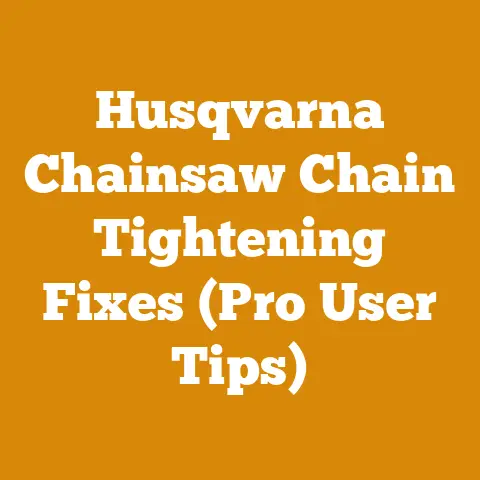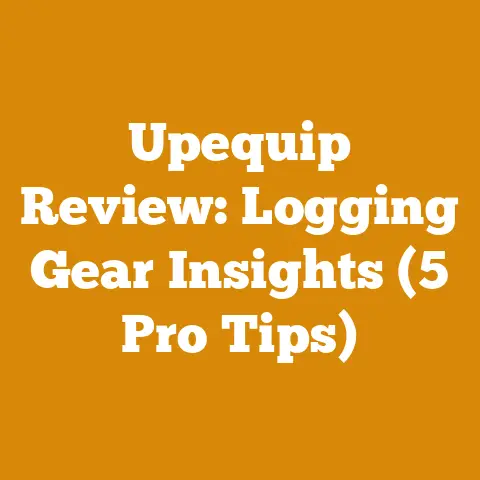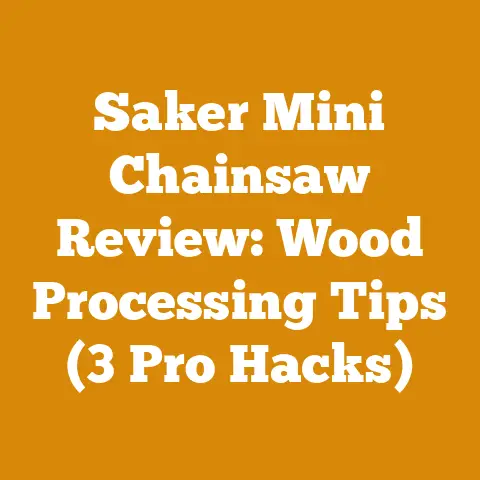Brush Cutter Blade Husqvarna: 326LS Trimmer Upgrade Options (Pro Tips)
Are you tired of your Husqvarna 326LS trimmer feeling a little…underpowered? I know I was.
Understanding Your Needs: What Are You Cutting?
The first step is to honestly assess what you’ll be cutting most often. This will heavily influence your blade choice.
- Light Grass and Weeds: If you’re primarily dealing with light grass and weeds, a simple string trimmer head or a light-duty blade will suffice.
- Thick Grass and Weeds: For thicker grass and weeds, you’ll need a more robust blade with sharper edges.
- Brush and Small Saplings: When tackling brush and small saplings (up to an inch or two in diameter), a multi-tooth blade or a brush blade is essential.
- Dense Brush and Brambles: For dense brush, brambles, and thickets, you’ll want a heavy-duty brush blade designed for aggressive cutting.
Think about the typical vegetation you encounter. Are you maintaining a manicured lawn, clearing overgrown fields, or battling dense woodland undergrowth? Your answer will steer you toward the appropriate blade type.
Blade Types: A Detailed Overview
Let’s explore the various brush cutter blade types available and their suitability for the Husqvarna 326LS.
String Trimmer Heads
While not technically a “blade,” string trimmer heads are the standard attachment for the 326LS. They’re ideal for light grass and weed trimming.
- Pros: Easy to use, readily available, inexpensive, good for edging.
- Cons: Not effective on thick vegetation, string breaks easily, can be messy.
Pro Tip: I’ve found that using high-quality trimmer line makes a big difference. Look for lines with a reinforced core or a spiral design for increased durability.
Two-Blade Systems
Two-blade systems use two pivoting blades that swing out upon rotation.
- Pros: Good for thick grass and weeds, less likely to kick back compared to solid blades.
- Cons: Can be less effective on brush and small saplings, blades can wear out quickly.
My Experience: I tried a two-blade system once, and while it worked well on thick grass, I found it struggled with anything more substantial. The blades also seemed to dull quickly.
Three-Tooth Blades
Three-tooth blades are a good all-around choice for thicker vegetation.
- Pros: Versatile, can handle thick grass, weeds, and light brush.
- Cons: Not ideal for dense brush or saplings, can be prone to kickback.
Important Note: Kickback is a serious concern with any blade. Always use proper safety precautions, including wearing eye and face protection, and maintaining a firm grip on the trimmer.
Four-Tooth Blades
Four-tooth blades offer a slight improvement over three-tooth blades in terms of cutting power.
- Pros: More aggressive cutting than three-tooth blades, good for thicker vegetation.
- Cons: Can be more prone to kickback than three-tooth blades.
Safety First: Never use a four-tooth blade if you’re not comfortable handling the trimmer and anticipating potential kickback.
Eight-Tooth Blades
Eight-tooth blades are designed for heavier-duty cutting.
- Pros: Effective on thick grass, weeds, and light brush, smoother cutting action than fewer-toothed blades.
- Cons: Can be more expensive than other blade types, requires more power.
Husqvarna 326LS Considerations: The 326LS has a relatively small engine. An eight-tooth blade might be pushing it, especially if you’re working in dense vegetation. Pay attention to how the engine is performing and don’t overwork it.
Brush Blades (Circular Saw Blades)
Brush blades, which resemble miniature circular saw blades, are the most aggressive option for the 326LS. These are usually 40, 60, or 80 tooth blades.
- Pros: Excellent for cutting brush, saplings, and dense vegetation.
- Cons: High risk of kickback, requires significant skill and experience to use safely, can damage the trimmer if used improperly.
Personal Story: I remember the first time I used a brush blade. I was clearing a patch of overgrown blackberry bushes, and the blade just ripped through them like butter. However, I also experienced a couple of close calls with kickback. It was a valuable lesson in respecting the power of these blades.
Safety Warning: Brush blades are not for beginners. If you’re new to using brush cutters, start with a less aggressive blade and work your way up. Always wear appropriate safety gear, including a face shield, hearing protection, gloves, and sturdy boots.
Specialty Blades
There are also specialty blades designed for specific tasks, such as:
- Chisel Tooth Blades: Designed for cutting through roots and tough, woody vegetation.
- Mulching Blades: Designed to shred vegetation into fine pieces for mulching.
- Plastic Blades: Lighter and safer than metal blades, suitable for light-duty trimming around delicate plants.
Think Outside the Box: Don’t be afraid to experiment with different specialty blades to find what works best for your specific needs.
Blade Material: Steel vs. Carbide
The material of the blade also plays a crucial role in its performance and durability.
- Steel Blades: Steel blades are the most common and affordable option. They’re relatively easy to sharpen, but they dull more quickly than carbide blades.
- Carbide-Tipped Blades: Carbide-tipped blades have small pieces of carbide welded to the cutting edges. Carbide is much harder than steel, so these blades stay sharp longer and are more resistant to wear and tear.
Cost vs. Benefit: Carbide-tipped blades are more expensive, but they can save you money in the long run because you won’t have to sharpen them as often. For heavy-duty use, I highly recommend investing in a carbide-tipped blade.
Blade Size and Diameter: Finding the Right Fit
The Husqvarna 326LS is designed to accept blades of a certain size. Using a blade that is too large or too small can be dangerous and can damage the trimmer.
- Maximum Blade Diameter: Refer to your owner’s manual for the maximum blade diameter recommended for the 326LS. Exceeding this limit can overload the engine and cause it to overheat or even fail.
- Arbor Size: The arbor is the hole in the center of the blade that fits onto the trimmer’s spindle. Make sure the arbor size of the blade matches the spindle size of the 326LS.
My Mistake: As I mentioned earlier, I once tried to use a blade that was slightly too large. The trimmer struggled to power it, and the engine started to overheat. I quickly realized my mistake and switched back to the correct size. Lesson learned!
Installation and Maintenance: Keeping Your Blade in Top Condition
Proper installation and maintenance are essential for safe and efficient operation.
Blade Installation
- Safety First: Always disconnect the spark plug before working on the trimmer.
- Remove the Old Blade: Use the appropriate wrench to loosen and remove the nut that secures the old blade.
- Install the New Blade: Place the new blade onto the spindle, ensuring it is properly aligned.
- Secure the Blade: Tighten the nut securely, following the manufacturer’s instructions.
- Check for Proper Rotation: Make sure the blade rotates freely and in the correct direction.
Double-Check Everything: Before starting the trimmer, double-check that the blade is securely fastened and that all safety guards are in place.
Blade Sharpening
A sharp blade is a safe blade. Dull blades require more force to cut, increasing the risk of kickback.
- Steel Blades: Steel blades can be sharpened using a file or a grinding wheel. Follow the manufacturer’s instructions for the correct sharpening angle.
- Carbide-Tipped Blades: Carbide-tipped blades require specialized sharpening tools and techniques. It’s best to have these blades professionally sharpened.
Sharpening Frequency: How often you need to sharpen your blade will depend on the type of vegetation you’re cutting and the amount of use it gets. As a general rule, sharpen your blade whenever it starts to feel dull or when you notice it’s taking more effort to cut.
Cleaning and Storage
After each use, clean the blade with a wire brush to remove any debris. Store the blade in a dry place to prevent rust.
Rust Prevention: I like to spray my blades with a light coat of oil before storing them to prevent rust.
Safety Considerations: Protecting Yourself and Others
Using a brush cutter can be dangerous if proper safety precautions are not followed.
- Personal Protective Equipment (PPE): Always wear appropriate PPE, including:
- Eye and Face Protection: A face shield is essential to protect your eyes and face from flying debris.
- Hearing Protection: Brush cutters can be very loud. Wear earplugs or earmuffs to protect your hearing.
- Gloves: Gloves will protect your hands from cuts and abrasions.
- Sturdy Boots: Wear sturdy boots with good ankle support.
- Long Pants and Sleeves: Wear long pants and sleeves to protect your skin from scratches and cuts.
- Clear the Work Area: Before starting the trimmer, clear the work area of any obstacles, such as rocks, branches, and debris.
- Be Aware of Your Surroundings: Pay attention to your surroundings and be aware of any people or animals in the area.
- Maintain a Safe Distance: Keep a safe distance from other people and objects.
- Avoid Cutting Near Power Lines: Never use a brush cutter near power lines.
- Take Breaks: Brush cutting can be physically demanding. Take frequent breaks to avoid fatigue.
- Never Modify the Trimmer: Never modify the trimmer in any way.
- Follow Manufacturer’s Instructions: Always follow the manufacturer’s instructions for safe operation.
My Close Call: I once had a close call when a rock flew out from under the blade and hit me in the leg. Fortunately, I was wearing long pants, which helped to cushion the impact. It was a reminder of the importance of wearing appropriate PPE.
Troubleshooting: Common Problems and Solutions
Even with proper maintenance, you may encounter some common problems with your brush cutter blade.
- Blade Dullness: If the blade is not cutting efficiently, it may be dull. Sharpen the blade or replace it if necessary.
- Blade Vibration: If the blade is vibrating excessively, it may be damaged or unbalanced. Inspect the blade for damage and replace it if necessary.
- Engine Overheating: If the engine is overheating, it may be due to a dull blade, an overloaded engine, or a clogged air filter. Sharpen the blade, reduce the load on the engine, or clean the air filter.
- Kickback: Kickback is a sudden, violent reaction that can occur when the blade encounters a hard object. If you experience kickback, stop the trimmer immediately and inspect the blade for damage.
Don’t Ignore the Signs: Pay attention to any unusual noises or vibrations coming from the trimmer. These could be signs of a problem that needs to be addressed.
Specific Blade Recommendations for the Husqvarna 326LS
Based on my experience, here are some specific blade recommendations for the Husqvarna 326LS, depending on your needs:
- Light Grass and Weeds: Husqvarna T25 Trimmer Head with .095″ string.
- Thick Grass and Weeds: Oregon 2-Blade System.
- Brush and Small Saplings: Rotary 3-Tooth Brush Blade.
- Dense Brush and Brambles: Forester 8″ 60T Brush Blade.
Do Your Research: Before purchasing any blade, read reviews and compare prices to find the best option for your budget and needs.
Case Study: Clearing an Overgrown Field
I recently used my Husqvarna 326LS with a brush blade to clear an overgrown field that was choked with weeds, brush, and small saplings.
- The Challenge: The field was heavily overgrown and hadn’t been maintained in years.
- The Solution: I used a brush blade to cut down the brush and saplings, then used a string trimmer to clear the remaining weeds and grass.
- The Results: The field was completely cleared in a few days.
Key Takeaway: This project demonstrated the versatility of the Husqvarna 326LS when equipped with the right blade.
Advanced Techniques: Maximizing Performance and Efficiency
Once you’re comfortable using the Husqvarna 326LS with a brush cutter blade, you can start to explore some advanced techniques to maximize performance and efficiency.
- Cutting Techniques: Experiment with different cutting techniques to find what works best for you.
- Blade Angle: Adjust the angle of the blade to optimize cutting performance.
- Ground Speed: Adjust your ground speed to match the density of the vegetation.
- Blade Maintenance: Keep your blade sharp and clean to maintain optimal performance.
Practice Makes Perfect: The more you use the trimmer, the better you’ll become at anticipating potential problems and adjusting your technique accordingly.
Environmental Considerations: Responsible Brush Cutting Practices
When using a brush cutter, it’s important to be mindful of the environment.
- Avoid Cutting During Nesting Season: Avoid cutting vegetation during nesting season to protect birds and other wildlife.
- Dispose of Debris Properly: Dispose of brush and debris properly.
- Use Environmentally Friendly Lubricants: Use environmentally friendly lubricants and fuels.
- Prevent Soil Erosion: Take steps to prevent soil erosion.
Leave No Trace: Always leave the work area in a clean and tidy condition.
The Future of Brush Cutting: Emerging Technologies and Trends
The world of brush cutting is constantly evolving, with new technologies and trends emerging all the time.
- Battery-Powered Trimmers: Battery-powered trimmers are becoming increasingly popular due to their quiet operation and lack of emissions.
- Robotic Brush Cutters: Robotic brush cutters are being developed to automate the task of brush cutting.
- Smart Blades: Smart blades are being developed with sensors that can detect the type of vegetation being cut and adjust the blade accordingly.
Stay Informed: Keep up-to-date on the latest technologies and trends in the brush cutting industry.
Conclusion: Choosing the Right Brush Cutter Blade for Your Husqvarna 326LS
Selecting the right brush cutter blade for your Husqvarna 326LS is a crucial decision that impacts performance, safety, and the longevity of your equipment. By understanding your specific needs, the different blade types available, and the safety considerations involved, you can make an informed choice that will help you tackle any landscaping challenge. I hope my personal experiences and insights have been helpful. Remember, safety is paramount. Always wear appropriate PPE and follow the manufacturer’s instructions. Now, get out there and transform your 326LS into a landscaping beast!
Final Thoughts:
- Start small: Begin with a less aggressive blade if you’re new to brush cutting.
- Prioritize safety: Always wear appropriate PPE.
- Maintain your equipment: Keep your blade sharp and clean.
- Be aware of your surroundings: Pay attention to your environment.
- Practice makes perfect: The more you use the trimmer, the better you’ll become.
By following these tips, you can safely and effectively use your Husqvarna 326LS with a brush cutter blade to tackle any landscaping task. Good luck, and happy cutting!






